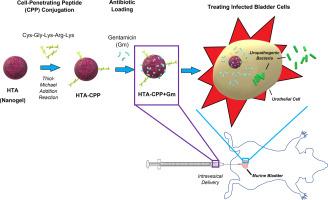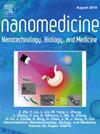Nanogels conjugated with cell-penetrating peptide as drug delivery vehicle for treating urinary tract infections
IF 4.6
2区 医学
Q2 MEDICINE, RESEARCH & EXPERIMENTAL
Nanomedicine : nanotechnology, biology, and medicine
Pub Date : 2025-02-28
DOI:10.1016/j.nano.2025.102812
引用次数: 0
Abstract
Among hospital–acquired infections, Pseudomonas aeruginosa-associated urinary tract infections (UTIs) are mainly caused by indwelling urethral catheters (catheter-associated UTIs or CAUTIs) and are difficult to treat, resulting in high rates of morbidity among hospitalized patients. While antibiotics can successfully treat bacteria in the bladder lumen, they are inefficient at crossing stratified urothelium plasma membranes to kill persistent intracellular bacterial communities (IBCs). Herein, we introduce an approach to target UTI IBCs by locally delivering the antibiotic gentamicin via polymeric nanogels conjugated with a cell-penetrating peptide Cys-Gly-Lys-Arg-Lys. This novel approach delivered ~36 % more intracellular gentamicin compared to drug delivered in solution in vitro. In an acute UTI murine model, the nanogel cell-penetrating peptide drug delivery system facilitated the transport of gentamicin into the urothelium and resulted in >90 % clearance of a uropathogenic P. aeruginosa clinical strain in vivo.

结合细胞穿透肽的纳米凝胶作为药物递送载体治疗尿路感染。
在医院获得性感染中,铜绿假单胞菌相关性尿路感染(UTIs)主要由留置导尿管引起,治疗难度大,住院患者发病率高。虽然抗生素可以成功地治疗膀胱腔内的细菌,但它们在穿过分层尿路上皮质膜杀死持续存在的细胞内细菌群落(IBCs)方面效率低下。在此,我们介绍了一种靶向UTI IBCs的方法,通过结合细胞穿透肽Cys-Gly-Lys-Arg-Lys的聚合物纳米凝胶局部递送抗生素庆大霉素。与体外溶液递送相比,这种新方法在细胞内递送的庆大霉素增加了~ 36% %。在急性尿路感染小鼠模型中,纳米凝胶细胞穿透肽药物传递系统促进庆大霉素运输到尿路上皮,并导致体内尿路致病性铜绿假单胞菌临床菌株bbb90 %的清除率。
本文章由计算机程序翻译,如有差异,请以英文原文为准。
求助全文
约1分钟内获得全文
求助全文
来源期刊
CiteScore
11.10
自引率
0.00%
发文量
133
审稿时长
42 days
期刊介绍:
The mission of Nanomedicine: Nanotechnology, Biology, and Medicine (Nanomedicine: NBM) is to promote the emerging interdisciplinary field of nanomedicine.
Nanomedicine: NBM is an international, peer-reviewed journal presenting novel, significant, and interdisciplinary theoretical and experimental results related to nanoscience and nanotechnology in the life and health sciences. Content includes basic, translational, and clinical research addressing diagnosis, treatment, monitoring, prediction, and prevention of diseases.

 求助内容:
求助内容: 应助结果提醒方式:
应助结果提醒方式:


